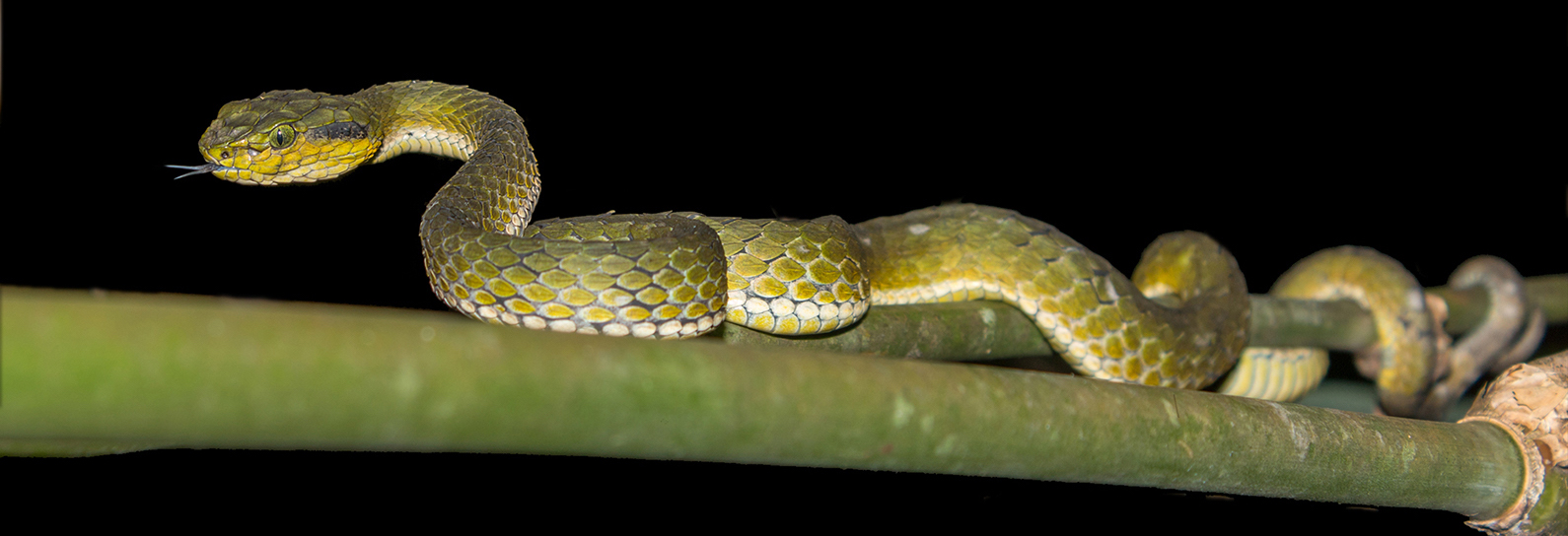A spate of new species of reptiles
While the idea of tropical rainforests teeming with diversity has typically evoked images of the Amazon or Borneo, a spate of species discoveries since the early 2000s has firmly established the Western Ghats as one of the leading centres of global biodiversity. A series of papers published in the last few weeks throws the spotlight on this region and its species once again. These studies were led by Kartik Shanker’s lab at the Centre for Ecological Sciences, Indian Institute of Science (IISc), in collaboration with other national and international institutions.

Although new frog species found here have received a lot of publicity, recent discoveries show that reptiles are just as diverse in this region. Starting with the discovery of a new genus called Proahaetulla antiqua in 2019, and several new species of vine snakes (Genus Ahaetulla) in 2020, Ashok Mallik and his colleagues have now described several new species of pit vipers (Genus Craspedocephalus) from the Western Ghats. As with the vine snakes, these new species of vipers are separated from each other by the physical barriers in these hill ranges such as the Palghat Gap and the Shencottah Gap.

Secondly, an even more iconic snake turns out to comprise many new species. The king cobra (Ophiophagus hannah) is distributed from India in the west to Philippines in the east. A large international collaborative effort, led by P Gowri Shankar, shows that the king cobra is composed of many evolutionary lineages that could be each be a unique species. This finding is of significance for both conservation prioritisation, as well as for the medical treatment of snakebite.
By far, however, the biggest bonanza comes from Cnemaspis, a widely distributed genus of day geckos (a type of lizard). Saunak Pal and co-authors describe 12 new species of this gecko from the Western Ghats in a recent paper. Including these, there are now 48 species of Cnemaspis in these mountains and 15 in peninsular India. Pal pays tribute to the martial arts and movie icon, Jackie Chan, by naming a species after him (Cnemaspis jackieii) as well as to Alfred Russel Wallace, the ‘father of biogeography’ (Cnemaspis wallaceii). Two other species are named after dragons from the Lord of the Rings (Cnemaspis smaug) and Game of Thrones (Cnemaspis balerion).
New species and genera have also been described in another group of lizards, the Agamids (to which garden lizards belong). Pal had described two new genera from the Western Ghats (Monilesaurus and Microauris) in 2018, while Achyuthan Srikanthan designated a new genus (Agasthyagama) earlier this year. Now, Gaurang Gowande and his team have discovered that the common garden lizard (Calotes versicolor), is composed of many different species in Peninsular India. Like the king cobra, this was believed to be a single widespread species throughout South and Southeast Asia but turns out to be a species complex (a group of closely related species).
These discoveries from the Western Ghats are the product of many years of systematic sampling that carefully accounted for the topographic, climatic, and habitat diversity of the Ghats. The work was funded by the Critical Ecosystem Partnership Fund (CEPF), Department of Biotechnology (DBT)-IISc partnership programme; Ministry of Environment, Forests and Climate Change (MoEFCC), Government of India, and other agencies.
The discoveries lend support to three significant messages. First, a systematic, geographically informed approach to sampling is critical, especially when there are many closely related, morphologically similar (or cryptic) species. Second, the extent of diversity of frogs and reptiles in the Western Ghats may well be true for other lesser studied groups such as insects, and for understudied regions such as the Eastern Ghats, other ranges, and needless to say for the vast and relatively unexplored parts of Northeast India. And finally, these findings highlight the importance of the conservation of these critical habitats.
REFERENCES:
https://vertebrate-zoology.arphahub.com/article/66239/
https://www.sciencedirect.com/science/article/abs/pii/S1055790321002335?via%3Dihub
http://www.zoores.ac.cn/en/article/doi/10.24272/j.issn.2095-8137.2021.074
https://vertebrate-zoology.arphahub.com/article/62787/
LAB WEBSITE:
https://kslab.weebly.com/





